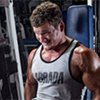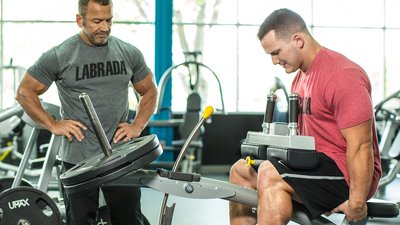Over the past couple of years, I have tried just about every workout technique, rep range, and exercise combo I could think of or read about. Some of these workouts and techniques were spectacular disasters, while others have become staples of my exercise program for all of my body parts.
Three of my personal favorites are manipulating time under tension, pre-exhaustion, and blood-gorging sets. The real payoff, however, comes from combining all three of these techniques—and five exercises—into one killer workout!
Time Under Tension
"Time under tension" refers to the time your muscle spends under load during a set, including the time spent in the concentric (shortening) phase, the peak contraction phase, and the eccentric (lengthening) phase. So if you perform a 10-rep set, and each rep takes three seconds to complete, your muscle experiences 30 seconds of time under tension.
Based on his own experience and research, a well-known strength coach named Charles R. Poliquin was able to develop optimal ranges of time under tension for particular training goals:
- Muscular hypertrophy (growth): 30-70 seconds per set
- Strength and size gains, or functional hypertrophy: 30-50 seconds
- Maximum hypertrophy without a strength emphasis: 50-70 seconds

Standing Calf Raise
Pre-Exhaustion
This training technique uses isolation movements to tire out a specific muscle group before moving on to a compound movement. For example, you could perform a chest fly before the bench press, or leg extensions before you squat.
Blood Gorging
This training technique involves doing high-rep sets of an exercise to create as intense of a pump as possible. These sets are typically performed with isolation movements such as triceps push-downs and leg curls.
Blood gorging is beneficial for a couple reasons. First and foremost, blood plasma is your body's primary shuttle for nutrients, amino acids, testosterone, and growth hormone. By ensuring maximum blood flow, your muscles are getting what they need to perform at their highest capacity and grow.
Additionally, a number of prominent bodybuilding trainers believe that including this type of work can help stretch your muscle fascia, the connective tissue that surrounds muscles and muscle groups. Creating more room in the fascia theoretically makes subsequent growth easier. I can't say if this is true or not, but based on the physiques of the people employing these techniques, as well as my personal experience with the technique, it seems reasonable.
How To Use These Techniques
I normally choose to use one or two of these techniques for any given workout. I might couple that technique with something else I like but don't do all the time, like dropsets or supersets. However, there is one muscle group for which I regularly like to use all three of the above techniques: legs. I've found that legs, more than other muscle groups, respond very well to the combination of all three.
In light of this, I want to share a leg workout I've been using regularly for a while now. This workout put some serious size on my legs, kept me injury-free, and never failed to leave me completely wiped out and sore.
One of the key components contributing to the effectiveness of this workout is the prescribed repetitions. The first set consists of 30 reps, 20 reps are performed for the next two, and 10 reps are performed for the last two sets, for a total of 5 sets. This is the number of sets and the rep scheme you will use for all five exercises in this workout. For each set, it is critical that you select a weight that makes the last 20 percent of your reps truly taxing. Don't slack on a single one of these sets!
These numbers and the order of the exercises may seem random, but I assure you they're not.

Seated Calf Raise
30 Reps
Doing 30 reps on the first set serves several purposes. First, it maximizes blood flow to the area being trained. The more blood you're able to provide a muscle, the more oxygen and nutrients it will be able to take in. In this sense, this set serves as a primer for the remaining 4 sets, since this set of 30 will give you an intense pump right from the start.
This set is geared toward maximum hypertrophy—the time your muscles spend under tension during 30 good reps should be no less than 60 seconds. Aim to have a one-second concentric (shortening/lifting) component. Also aim to have a one-second eccentric (lengthening/lowering) component.
20 Reps
For the next two sets of 20 reps, your time under tension should be no less than 60 seconds. Once again, aim to have a 1-second concentric component, but now shoot for an eccentric component of 2-3 seconds.
10 Reps
The purpose of the last two sets, performed at 10 reps apiece, is to build strength as well as muscle. When you perform these sets, the weight lifted should be heavy, relative to your strength level, and you should spend 35-40 seconds under tension. Aim to have a 2-second concentric and a 2- to 3-second eccentric component. As you fatigue, these targets will grow harder to maintain, but do your best!
Exercise Order
The other key component of this workout is the order in which you perform the exercises. Many people find it odd to start with calves, but that's why, in my opinion, so many people have lagging calves. Training them when you have a full tank of gas and you can give them the time and energy they deserve, as opposed to doing them when you're running on fumes and the only things on your mind are a protein shake and a nap. Also, being a relatively small muscle, calves don't demand as much energy as other body parts, so you'll still be ready to rock and roll when it comes time for the rest of the workout.
You'll be doing two isolation movements—the pre-exhaustion component of the workout—before moving on to the compound movement. Isolating the quadriceps and hamstrings before you perform your leg press offers two key benefits. First, your legs will be warm and full of blood, meaning you can get right to work instead of performing several warm-up sets.

Leg extensions, a single-joint quad movement, normally come last in your leg routine. By putting them before other multijoint exercises, your quads are now pre-fatigued, making every movement that follows that much more difficult.
Second, and most important, your legs will be fatigued to a point where you can still push good weight around—but you aren't going as heavy as you would if you started with the compound motion. The stronger you get, the more relevant this benefit will be, as you avoid using poundages that open you up to injury and tax your central nervous system. In the long run, this will lead to fewer missed workouts and the ability to perform at your highest level more consistently.
The end result of this workout should be a great pump, wrecked legs, and over time, progress! Let's get after it!
HUNTER LABRADA'S LEG WORKOUT
Watch The Video - 9:31
1. Standing Calf Raise
Contract your calves at the top of each rep, and don't bounce at the bottom of the rep into the next. Also, keep your core tight and your glutes and quads tensed, as this will give you the most stability possible and isolate your calves. This exercise targets the gastrocnemius, the muscle that people traditionally think of when they think of a calf muscle.
Standing Calf Raise In Slow Mo
Watch The Video - 0:59
2. Seated Calf Raise
When you do your seated calf raises, the main thing to keep in mind is to use a full range of motion. However, don't shift tension from your calves to your Achilles tendons by stretching too far at the end of each rep. This exercise targets the soleus, the muscle that runs underneath the gastrocnemius and is activated when the knee is bent. Having well-developed soleus muscles will make your calves pop more and add to their overall size.
Seated Calf Raise In Slow Mo
Watch The Video - 0:50
3. Leg Extension
Leg extensions work to pre-exhaust your quads, which will get slammed soon enough by leg presses. Before starting your reps, make sure the machine's pad position, seat position, and range-of-motion stop are set properly for your body. Once the reps begin, don't lock out your knee at the top; at the bottom, don't allow the pad to go so far back that it stretches your patella tendon and deloads your quad. These two form mistakes are the main reasons leg extensions have a bad rap for being knee-beaters, so be sure to avoid them!
Leg Extension In Slow Mo
Watch The Video - 0:54
4. Lying Leg Curl
This isolation exercise serves as the pre-exhaust movement for your hamstrings. As with leg extensions, the first priority is making sure the machine is set properly for your body. When performing your lying leg curls, pretend you are training your biceps, in the sense that each rep should be performed in a controlled, nonballistic fashion with a full squeeze at the top of the rep. Also, be sure to keep your hips and pelvis firmly planted and driven into the machine. This small tweak will help isolate your hamstrings as much as possible. Do not let your butt come flying up when you perform this exercise!
Lying Leg Curl In Slow Mo
Watch The Video - 0:51
5. Leg Press
This workout closes with a leg press instead of a squat, because if you've performed the previous exercises as intensely as you should have, you will be experiencing a minor case of what I like to call "newborn-baby-giraffe legs." Go watch a video of one if you don't know what I'm talking about, and you'll get the picture.
Jokes aside, though, at this point in the workout, your legs will be pretty shot, so I like to use an exercise where I can focus on maximum exertion without having to stabilize free weight. Hence the use of the leg press.
When performing this exercise, be sure to use a full range of motion, and avoid locking at your knees at the top or descending so far that your hips start to roll under you and your butt begins to come out of the machine. Using proper form will keep the tension on your quads where it belongs, and not on your knees or other vulnerable joints.
Leg Press In Slow Mo
Watch The Video - 0:39

